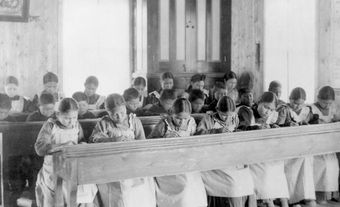The word reconciliation is used a lot in Canada. It is closely tied with Indigenous peoples. Indigenous peoples were harmed in many ways in the past. Children were abused in residential schools. Their languages and cultures were taken from them (see Genocide and Indigenous Peoples in Canada). The key goal of reconciliation is to heal the wounds of the past and make reparations for these wounds. Reconciliation also includes making a better future. In Canada, the process of reconciliation has only recently started. The process will continue for a long time.
This article is a plain-language summary of Reconciliation in Canada. If you are interested in reading about this topic in more depth, please see our full-length entry, Reconciliation in Canada.

Definition
In 2008, the Truth and Reconciliation Commission (TRC) was created. The TRC had many purposes. One main purpose was to gather evidence about student experiences at residential schools. Living former students of residential schools are known as Survivors. Another purpose was to allow Survivors to speak publicly about their experiences. Many of them were tragic. Abuse was widespread. The ultimate purpose in telling these stories was to start the process of reconciliation. First, the truth had to be known. Then, those responsible for the abuse had to admit what they did. After this, they had to change. Part of this change involved repairing the damage that occurred.
Historical Context and Reconciliation Efforts
The term reconciliation started to be used a lot in the late 1990s. The term was included in a report by the federal government. It was in response to the Royal Commission on Aboriginal Peoples. The Royal Commission on Aboriginal Peoples examined many topics, including residential schools. The government’s report included a Statement of Reconciliation. It called for the recognition of wrongs done to Indigenous peoples. One of these wrongs was trying to make the Indigenous peoples assimilate. The federal government pledged $350 million dollars to community-based healing for Indigenous peoples. More specifically, the goal was to help the survivors of abuse. Many students suffered from sexual abuse and physical abuse. Prime Minister Stephen Harper apologized in 2008.
In 2005, the federal government promised money to the Survivors of residential schools. It also promised to create a Truth and Reconciliation Commission (TRC). The TRC made the term reconciliation more widespread. For reconciliation to occur, the TRC made recommendations, called Calls to Action. It called on school boards to teach about residential schools. It also called on other institutions to make changes. These institutions included child welfare agencies, health care, and the justice system.
Currently, the term reconciliation is better known than ever before. Since 2021, Canada now recognizes the National Day for Truth and Reconciliation on 30 September. This date is also Orange Shirt Day. Some Indigenous people believe that the term reconciliation is unclear.
Indigenous groups have won many court cases about land claims. They have also received some support from politicians. In 2019, politicians in British Columbia supported the Indigenous peoples of B.C. The B.C. government implemented the United Nations Declaration on the Rights of the Indigenous Peoples. However, many Indigenous leaders are not satisfied. They say that the government does not listen to them. They also say that the government does not do much to help their communities.
Many do not have clean drinking water. There is less access to good quality education. Many communities do not have enough homes. Some homes in Indigenous communities are not safe. In sum, many Indigenous peoples think that much more has to be done.
The Future of Reconciliation
Canadians know much more about Indigenous peoples now than they did before. For example, they understand the negative effects of colonization. To try and repair the damage, governments and institutions have made some changes. That said, it will take much time to heal wounds of the past and to make necessary changes.

 Share on Facebook
Share on Facebook Share on X
Share on X Share by Email
Share by Email Share on Google Classroom
Share on Google Classroom


